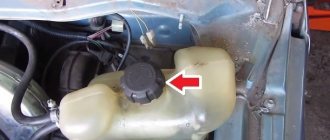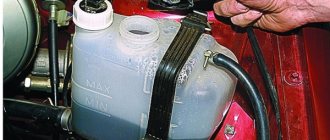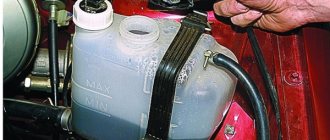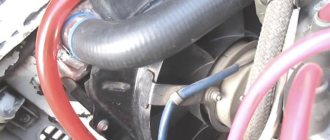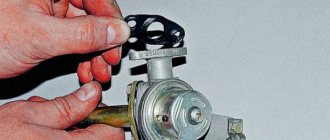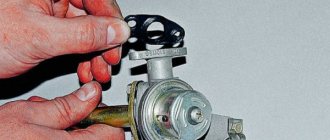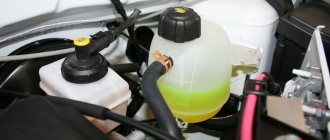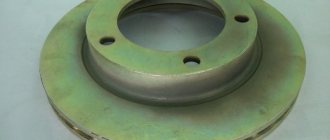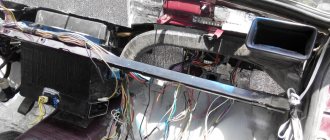Let's pre-flush the system with a special flush.
First, you need to drain the old fluid from the radiator and engine block; they have a faucet and a drain plug, respectively.
We use a suitable hose for convenience - the liquid is toxic.
In our case, a pre-heater is installed on the engine instead of a plug, so we’ll simply remove one of its pipes.
We open the caps of the radiator, tank and heater tap for better release of liquid. About 8 liters of antifreeze should drain (cooling system capacity 8.6 liters).
Now we will flush the system with water from a hose under pressure, after closing the radiator tap until clear liquid begins to come out of the block.
Then we close the drain holes, fill in the flush and fill the system with water.
To better remove air, remove one of the throttle heating pipes until liquid flows out, and put it back on.
We start the engine and, according to the instructions, let it run for 10-15 minutes, at the same time adding water and pressing the upper pipe until the air stops escaping.
This time is just enough to warm up the engine to 100 °C by the time the cooling fan turns on.
At the same time, turn on the interior heater fan at full power and open the tap to clean the radiator.
After warming up, turn off the engine, let it cool a little and drain the flushing fluid.
No large flakes or inclusions were found.
We rinse the engine again with running water and let it drain thoroughly. While it is draining, you can replace worn out and stiffened pipes (it is better to replace them as a set).
In our case, this is a pair of pipes going to the thermostat; one cracked; the other, due to loss of elasticity, was leaking liquid that dripped onto the generator.
Now you can start filling in new antifreeze; first close all drain holes.
Approximately 8.6 liters of antifreeze should enter the system. To better fill the system, we again remove the throttle heating hose, start the engine and, as air leaves the radiator, top it up, pushing through the upper pipe.
When the air stops escaping, fill the liquid up the neck and close the radiator cap. Fill the expansion tank above the min mark.
Warm up the engine to operating temperature, keeping an eye on the pipes. Don’t forget to turn on the stove; warm air should blow from it, then hot air as it warms up.
When the fan operates, turn off the engine, check the pipes for leaks, and tighten them if necessary. In this case, the level in the tank should rise slightly and drop as it cools.
Also, over the next few days, we check whether there is any liquid dripping anywhere, since when washing, the old protective layer from additives is removed, and a new one has not yet formed.
PURPOSE OF COOLANT FOR VAZ 2107
It’s easy to guess the purpose of the coolant from its name. It serves to remove excess heat from the engine. It's simple: in any internal combustion engine there are many rubbing parts, which during operation can heat up to a temperature of 300°C. If these parts are not cooled in time, the engine will fail (and the pistons and valves will be the first to suffer from overheating). This is where coolant comes to the rescue. It is supplied to a running engine and circulates there through special channels, taking away excess heat.
The general principle of operation of the liquid cooling system of the VAZ 2107
Once heated, the coolant goes into the central radiator, which is constantly blown by a powerful fan. The liquid cools in the radiator and is then sent back to the cooling channels of the engine. This is how continuous liquid cooling of the VAZ 2107 engine is carried out.
ABOUT ANTIFREEZE AND ANTIFREEZE
It should be said right away that dividing coolants into antifreeze and antifreeze is accepted only in Russia. To understand why this happened, you need to answer the question: what is coolant anyway?
As a rule, the base for the coolant is ethylene glycol (in rare cases, propylene glycol), to which water and a set of special additives are added to prevent corrosion. Different manufacturers have different sets of additives. And all coolants on the market today are classified according to the technologies for producing these additives. There are three technologies:
- traditional. Additives are made from salts of inorganic acids (silicates, nitrites, amines or phosphates);
- carboxylate. Additives in carboxylate fluids are obtained only from organic carbonates;
- hybrid. In this technology, manufacturers add a small percentage of inorganic salts (most often phosphates or silicates) to organic carbonate additives.
Coolant made using traditional technology is called antifreeze, and liquid made using carboxylate technology is called antifreeze. Let's take a closer look at these liquids.
Antifreeze
Antifreeze has several advantages. Let's list them:
- protective film. The inorganic salts contained in antifreeze form a thin chemical film on the surface of the cooled parts, which reliably protects the parts from corrosion. Film thickness can reach 0.5 mm;
Antifreeze creates a uniform protective layer, but at the same time prevents heat removal - color change. Even if the driver forgot to change the coolant, he will easily understand that it is time to do it simply by looking into the car's expansion tank. The fact is that antifreeze becomes darker as it ages. Very old antifreeze resembles tar in color;
- price; Antifreeze produced using traditional technology is about a third cheaper than antifreeze.
Antifreeze A40M - inexpensive domestically produced coolant
Of course, antifreeze also has disadvantages. Here they are:
- small resource. Antifreeze quickly becomes unusable. It needs to be changed every 40–60 thousand kilometers;
- effect on aluminum parts. The additives contained in antifreeze negatively affect the aluminum surfaces in the main radiator. In addition, antifreeze can form condensation. These factors significantly reduce the service life of aluminum radiators;
- influence on the water pump; The tendency to form condensation can also have a detrimental effect on the VAZ 2107 water pump, leading to premature wear of its impeller.
ANTIFREEZE
Now let's look at the pros and cons of antifreeze. Let's start with the pros:
- long service life. On average, six liters of antifreeze are enough for 150 thousand kilometers;
- temperature selectivity. Thanks to carbonate additives, antifreeze can more actively protect the engine surface that is hottest than others;
Antifreeze does not interfere with heat dissipation and effectively protects corrosion areas using local layers - long engine operation. The above temperature selectivity leads to the fact that an engine cooled by antifreeze does not overheat much longer than an engine cooled by antifreeze;
- no condensation. Antifreeze, unlike antifreeze, never forms condensation, and therefore cannot damage the radiator and water pump of the car.
And antifreeze has only one disadvantage: high cost. A canister of high-quality antifreeze can cost two or even three times more than a canister of good antifreeze.
Taking into account all the above advantages, the vast majority of VAZ 2107 owners opt for antifreeze, since saving on coolant has never led to anything good. Almost any antifreeze, both domestic and Western, is suitable for the VAZ 2107. Most often, car owners prefer to use Lukoil G12 RED antifreeze.
Lukoil G12 RED is the most popular brand of antifreeze among VAZ 2107 owners
Other, less well-known brands of antifreeze are Felix, Aral Extra, Glysantin G48, Zerex G, etc.
Timing for replacing coolant in VAZ 2107
The purpose of the coolant in the VAZ 2107 is to remove excess heat from the car’s engine. Indeed, during operation, many parts of an internal combustion engine reach temperatures of 300 degrees C. If the engine is not cooled in time and sufficiently, it will fail. Coolant solves this problem; it is supplied to a running engine, flows through the channels, thus taking away excess heat from the internal combustion engine.
After heating, the coolant goes into the central radiator, which is constantly blown by the fan. After cooling in this unit, the liquid returns to the engine cooling channels. This is the procedure for continuous liquid cooling of the VAZ 2107 engine.
The general principle of operation of the VAZ 2107 cooling system can be studied using the diagram below.
How to understand what kind of coolant is required for a VAZ 2107 - antifreeze or antifreeze? Since we are talking about Russian cars, we should distinguish between concepts such as antifreeze and antifreeze to clarify concepts.
It should be noted that such division and differentiation is accepted only in the Russian Federation. To answer this question, you must first understand: what is coolant?
We recommend: Replacing the radiator of the VAZ 2109 stove
So, the basis of the coolant is ethylene glycol, less often propylene glycol. Special additives are added to it, which protect against corrosion. Each manufacturer adds different types of additives.
Let us differentiate the coolants available on the modern market according to additive production technologies:
- traditional, in which additives are made from salts of inorganic acids: silicates, nitrites, amines, phosphates;
- carboxylate, additives are made from organic carbonates;
- hybrid, consists of a mixture of organic carbonate additives and inorganic salts (in smaller quantities, including phosphates or silicates).
So, the main difference between antifreeze and antifreeze is that coolant made using traditional technology is called antifreeze, while coolant made using carboxylate technology is called antifreeze.
Advantages and disadvantages of using antifreeze
Pros:
- protective film. Thanks to the inorganic salts contained in antifreeze, a protective film is created on the surface of the cooled parts, protecting them from corrosion. The film reaches 0.5 mm. In the picture below you can see how antifreeze creates a protective layer, the disadvantage is that it interferes with heat removal;
- color change. If the driver forgot to change the coolant, a clue to the need for the procedure will be the color of the liquid, which is easy to notice just by looking into the car's expansion tank. The changes are that as the antifreeze loses its useful properties it becomes darker, and completely unusable antifreeze cannot be distinguished from tar;
- affordable prices. Coolant produced using traditional technology is 3 times cheaper than antifreeze.
Disadvantages of antifreeze:
- replacement frequency. Antifreeze has a short lifespan, becoming unusable after 50 thousand kilometers;
- negative impact on aluminum parts. The additives used to create antifreeze negatively affect the aluminum surfaces in the main radiator (which significantly reduces its service life);
- due to the tendency to form condensation, it negatively affects the water pump of the VAZ 2107, as a result - premature wear of its impeller.
Let's look at the advantages and disadvantages of using antifreeze
Pros:
- service life is longer - 6 liters of antifreeze is enough for 150 thousand kilometers;
- temperature selectivity - due to the presence of carbonate additives, antifreeze more actively protects the engine surface that is heated the most;
- antifreeze does not interfere with heat dissipation, and also protects corrosion areas with the help of local layers;
- long engine operation due to temperature selectivity and timely engine cooling with antifreeze;
- there is no condensation, which means antifreeze cannot damage the radiator and water pump of the VAZ 2107.
The disadvantage of antifreeze is obvious - its high cost. In terms of price, it is on average 3 times higher than antifreeze.
FLUSHING THE COOLING SYSTEM
Flushing the cooling system is a very important procedure, since the cooling efficiency of the VAZ 2107 engine depends on it. At the same time, many car enthusiasts prefer not to flush the cooling system, but to fill in new antifreeze immediately after draining the old one. As a result, the remnants of the old antifreeze are mixed with the new coolant, which has an extremely negative effect on its performance. That is why it is strongly recommended to flush the engine cooling system before adding new antifreeze. This can be done either with water or with the help of special compounds.
FLUSHING THE COOLING SYSTEM WITH WATER
It should be said right away that it is advisable to use this washing option only when there is no good washing liquid at hand. The fact is that ordinary water contains impurities that form scale. And if the driver still decides to flush the cooling system with water, then the best choice in this situation would be distilled water.
WATER RINSE SEQUENCE
- Distilled water is poured into the expansion tank of the VAZ 2107.
Distilled water is poured into the expansion tank of the VAZ 2107 - The engine starts and idles for half an hour.
- After this time, the engine is turned off and the water is drained.
The water drained from the VAZ 2107 must be as clean as the water being poured - After this, a new portion of water is poured into the tank, the engine starts again, runs for half an hour, then the water is drained.
- The procedure is repeated until the water drained from the system becomes as clean as the water being poured. Once clean water appears, washing stops.
WASHING THE COOLING SYSTEM WITH A SPECIAL COMPOSITION
Flushing the cooling system with a special composition is the best, but also very expensive option. Because cleaning products effectively remove residual grease, scale and organic compounds from the system. Currently, VAZ 2107 owners use two-component flushing fluids, which contain both acids and alkalis. The most popular liquid is LAVR. Cost - from 700 rubles.
LAVR flushing fluid is the optimal choice for flushing the VAZ 2107 cooling system
SEQUENCE OF WASHING THE SYSTEM WITH A SPECIAL LIQUID
The sequence of flushing the cooling system with a special composition is practically no different from the sequence of water flushing mentioned above. The only difference is the operating time of the motor. This time must be clarified (it depends on the composition of the selected flushing liquid and must be indicated on the canister with flushing).
Comparison of VAZ 2107 radiator tubes before and after flushing with LAVR
Instructions for replacing antifreeze
Antifreeze, compared to water, is quite resistant to frost - it does not freeze. It is also not a source of scale, which means it does not clog the cooling system.
But, subjected to constant temperature influences and fluctuations, antifreeze loses its properties during operation:
- the boiling point decreases and accordingly becomes equal to the boiling point of water;
- The fluid may freeze, resulting in a cracked reservoir or cracked cylinder block.
For these reasons, it is necessary to change antifreeze at least once every six months. It is important to do this during seasonal car maintenance. Timely replacement of coolant will help avoid unpleasant consequences, unwanted repairs and unnecessary waste of money.
So, replacing antifreeze on a VAZ 2107 includes draining the antifreeze, flushing the cooling system (if necessary) and replacing the used coolant with new antifreeze or antifreeze.
You should first prepare the following materials and tools:
- canister with new antifreeze (6 liters);
- funnel;
- wrench “13”;
- open-end wrench “16”;
- key “12”;
- an empty container of 6-10 liters (a cut canister is often used);
- a clean rag made from natural fabrics;
- Protect your hands with gloves.
Drain
Draining antifreeze from the VAZ 2107 tank includes the following sequence of actions:
- Place the car on the inspection hole so that the front wheels of the car are higher than the rear ones;
- Move the lever (located on the dashboard) that supplies warm air into the cabin as far as possible to the right;
- Open the hood and unscrew the expansion tank cap;
- Unscrew the central radiator cap;
- Using a 16mm open-end wrench, unscrew the drain plug located on the cylinder block. Place a container prepared in advance, as liquid will begin to pour out. It may take up to 10 minutes to completely drain the spent fluid;
- Using a “12” wrench, unscrew the plug on the radiator drain hole, located in its lower part. A special bucket or container is used for draining;
- Remove the belt holding the expansion tank by hand. You should raise the tank as high as possible, thus draining the remaining antifreeze from the hose connected to the tank;
- After completing the procedure for draining antifreeze or antifreeze, the tank is installed in place, all drain holes are then closed and the cooling system must be flushed.
Flushing
Flushing the cooling system is an important procedure. It determines how effectively the VAZ 2107 engine will be cooled. A number of car owners believe that flushing the cooling system is a waste of time, and immediately fill in new antifreeze or antifreeze after draining the used fluid. This causes clean and dirty fluid to mix, negatively affecting performance.
You can flush the cooling system using either water or special products.
Cleaning OS with water
Flushing the cooling system with water is only allowed if there is no flushing liquid. The fact is that ordinary water contains impurities that contribute to the formation of scale. If the choice is water, it is better to use distilled water.
Sequencing:
- Water is poured into the expansion tank of a VAZ 2107;
- Let the engine idle for 30 minutes;
- After half an hour has passed, the engine is turned off and the water is drained;
- Repeat the procedure until the water drained from the system is as clean as the water being poured in;
- Stop the procedure after clear water appears.
Cleaning the OS with a special agent
You can also flush the cooling system with a product containing special impurities. This is a more expensive way to clean the system, but in the long term the most appropriate option, since the product removes from the tank:
- fat deposits;
- dissolves and removes scale from the tank;
- organic compounds.
Today, VAZ 2107 car owners use flushing fluids, the two main components of which are acids and alkalis. Car owners prefer LAVR, which costs from 700 rubles.
The sequence of actions when flushing the cooling system with a special liquid is no different from flushing with water. The only significant difference is the operating time of the motor, which is indicated on the canister of liquid.
After flushing the radiator tubes of a VAZ 2107 with LAVR, the positive result is obvious.
Bay
After the actions have been taken, it is time to fill in new antifreeze (or antifreeze, if such a decision was made by the VAZ 2107 car owner).
How to replace antifreeze on a VAZ 2107 injector? Sequencing:
- Open the radiator cap and insert a funnel into it;
- The following actions are carried out with the help of a partner. The plug is removed from the cylinder block and antifreeze is slowly poured in. At the same time, tighten the bolt, and as soon as the antifreeze flows out of the BC, the bolt is tightened. Such a maneuver will help eliminate the creation of air jams;
- Pour antifreeze into the radiator until it is completely filled;
- Pour antifreeze into the expansion tank until it reaches the radiator. Then screw on the tank cap;
- The tank is the last to be filled. The level corresponds to the norm. Upon completion of all procedures, the lid is screwed on;
- Start the engine and warm it up to operating temperature to check the proper operation of the cooling system. The cooling fan should work and the temperature should drop, which means the system is in working order.
We recommend: How to change the oil filter without changing the oil?
This completes the replacement of antifreeze in the VAZ 2107 injector. There is no need for special knowledge or special equipment to perform this procedure. It is enough to have a set of tools and decide on a place.
You should also pay attention to the fact that antifreeze, like antifreeze, is a toxic substance. Consequently, a number of safety measures are observed when replacing coolant on a VAZ 2107:
- Do not dump antifreeze on the floor in the garage or on the ground in the yard. The liquid is poisonous and can harm the human respiratory system;
- Protect your skin and do not allow antifreeze to get on your hands or in your mouth. A number of motorists check the nature of the fluid used by dipping their finger into the reservoir. The consequences may be poisoning or burns;
- If antifreeze gets on your hands, face, eyes, or mouth, rinse with a stream of cold water and take the victim to a specialist, or call an ambulance. Antifreeze, like antifreeze, is first of all a liquid hazardous to health, and only then a necessary component for the proper operation of a VAZ 2107 car;
- Do not have a snack while working on replacing antifreeze in the VAZ 2107. In this way, you can swallow the evaporated toxic liquid;
- Wash your hands after completing the antifreeze replacement procedure. This is done several times with running water, after which the skin should be protected with a special cream (especially important if antifreeze gets on the skin of your hands).
By adhering to the described recommendations, the driver of a VAZ 2107 car will protect both himself and others from unpleasant consequences, poisoning, burns, etc.
Stages of replacing coolant VAZ 2107
On most classic Lada cars, drainage is provided from the radiator, as well as the engine. But before adding new antifreeze, it is recommended to flush the cooling system to prevent impurities from getting into the new liquid.
During the production of the VAZ 2107, a large number of modifications were produced, which were equipped with various engines. But at the moment the most popular are gasoline versions in carburetor and injector versions.
There are no global differences in the carburetor and injection versions when replacing, all actions will be almost the same. The difference will only be in the release of air when adding new fluid.
Before you start replacing the coolant, to avoid getting burned, you need to wait until the engine has completely cooled down. You should also avoid getting antifreeze or antifreeze on the skin, eyes or digestive organs, since the chemical composition of the liquids is toxic.
Coolant drain
Before starting the draining procedure, you should prepare tools, containers for used antifreeze, as well as new liquids for subsequent refilling. If protection is installed under the engine, it can also be removed for convenience.
Next, we perform the procedure for draining the liquid from the VAZ 2107:
- Turn the temperature regulator in the cabin to the maximum position to the right (Fig. 1).
Fig.1 Temperature control - We find the plug in the bottom left corner of the radiator and unscrew it, after placing a drain container under the radiator. (Fig.2). On older versions, this plug is not present; a fan switch sensor is installed there. To drain the antifreeze, you need to unscrew it; this can be done with a 30mm wrench. Fig.2 Radiator drain plug
- After this, unscrew the plug on the radiator filler neck, as well as on the expansion tank, to drain the liquid more quickly (Fig. 3). Fig.3 Caps on filler necks
- Unfasten the fastening of the expansion tank and lift it up (Fig. 4). In this case, the liquid will drain through the radiator drain hole. And the tank itself can be completely removed and washed. Fig.4 Mounting the tank
- To drain the coolant from the engine, you need to unscrew the drain bolt using a 13mm wrench. The bolt itself is located on the left side; you can place a watering can under it to reduce splashing of the liquid (Fig. 5). Fig.5 Drain bolt on the engine block
After completing this operation, do not forget to put the expansion tank in place. And also tighten all drain plugs if you skip the flushing stage.
Flushing the cooling system
If there are deposits in the drained liquid or there is a transition from antifreeze to antifreeze, the system should be flushed. To do this you need to do the following:
- Flush the system with plain water through the expansion tank of the VAZ 2107. The plugs must be open;
- tighten the drain plug and bolt;
- fill the system with a flushing agent (you can use Liqui Moly Kuhlerreiniger or Lavr cooling system flush) with distilled water (6-7 liters);
- start the engine. Warm up to 90 degrees;
- leave it idling for 5-10 minutes, depending on the contamination of the system;
- muffle it. Allow the engine to cool to approximately 60 degrees;
- drain the flush using the same steps as removing the old fluid;
- tighten both plugs;
- fill with distilled water to rinse the cooling system;
- start the car and warm up to 90 degrees;
- turn off and let cool to 60 degrees, drain;
- repeat steps 8, 9, 10 and 11 if necessary.
Filling without air pockets
To fill new fluid into the cooling system, you can use the instructions described in the book on car repair and operation. But when doing this, motorists very often end up with air jams.
Air locks can cause overheating of the VAZ 2107 (Zhiguli) engine, as well as its boiling. Very often, the heating stove may not work.
So, let's start filling it correctly:
- If you have an injector, then remove one of the hoses going to heat the throttle assembly (Fig. 6).
Fig.6 Hoses for heating the throttle - If you have a carburetor, then remove the rubber hose from the fitting above the intake manifold (Fig. 7).
Fig.7 Rubber hose - The drain plug on the radiator should be closed and the drain plug on the engine block should be open. We begin to pour antifreeze into the radiator. As soon as it flows from the hole on the block, screw the bolt into place.
- We continue to pour antifreeze until it flows from the places indicated in Figures 6 or 7, depending on the modification. After that we put the hoses in place.
- Now fill the radiator to the top of the neck and screw on the cap. Fill the expansion tank a few centimeters above the MIN mark.
- We start the car, warm it up to operating temperature, let it run for 5 minutes, then turn it off.
Thus, the filling of coolant without the formation of air pockets is completed. All that remains is to wipe off the spilled antifreeze and wait for the engine to cool. With the car now cooled down, check the level in the expansion tank again and top up if necessary.
Replacing antifreeze in a VAZ 2107
Let's move on to replacing antifreeze in a VAZ 2107. Conventionally, the procedure can be divided into 3 stages: draining the old antifreeze, flushing the cooling system and adding fresh fluid.
Draining old antifreeze
The first step is to remove the engine crankcase protection, if there is one. On Zhiguli cars it is most often in a deplorable state, so it is better to use special means that will free soured bolts, for example, WD-40 or EFELE UNI-M Spray.
Remember that on older cars the bolts rust over time and become very brittle, so you need to be careful when removing them.
Next, you need to move the heater control lever to maximum from inside the car. There is no need to start the heater itself. After this, open the filler neck of the radiator and expansion tank. This will allow you to drain the old antifreeze faster.
Depending on the radiator model, there may be two options for draining the liquid. If an original radiator from the latest models is installed, you need to find a special faucet on it to drain the coolant. As a rule, it turns sour during operation, so it must be pre-treated with the agents mentioned above, and then carefully opened and drained of the antifreeze.
On cars that are equipped with a radiator from older models, you can unscrew the fan switch off sensor, which is located on the inside of the radiator on the right side, if you are facing the car, or remove the hose from the lower radiator pipe.
After draining the antifreeze from the radiator, you need to remove the coolant from the internal circuit of the cooling system. We find a drain plug on the cylinder block - it looks like an ordinary 13 bolt. We unscrew it and drain the antifreeze through a pre-prepared hose.
Next, you should drain the antifreeze from the expansion tank. Unfasten the belt securing the container and lift it 30-40 centimeters up. This will allow the remaining antifreeze to enter the radiator, and from there into the collection container.
Flushing the cooling system
Flushing the engine cooling system is not a mandatory procedure. But there are situations when it is necessary. For example, when switching to another antifreeze. This is due to the fact that different brands of coolants have different chemical compositions. Therefore, in this case it is better not to neglect it.
Flushing is also necessary if there are plugs or serious contaminants in the cooling system that negatively affect engine operation.
It would be a good idea to flush the cooling system in a recently purchased car. Many owners of domestic cars most often use cheap antifreeze, after which it is best to perform this procedure.
If you flush the system, do not forget about the expansion tank. All hoses need to be disconnected from it and removed from the mounts, and then thoroughly rinsed from the inside.
Read more about how and what to flush the engine cooling system in our article on this topic.
Rinsing with distilled water
The simplest method. It is used only when the system is slightly contaminated.
The procedure looks like this:
- Distilled water is poured into the system through the expansion tank. Tap water is not recommended. Because of this, scale forms in the system. The volume of water for washing is 7-9 liters.
- The expansion tank plug is screwed in. The engine starts and warms up at idle speed to operating temperature. This is checked using the lower radiator pipe. The operating temperature is achieved when the upper and lower nozzles are heated equally. Then the motor warms up for 15-20 minutes.
- The engine stops and cools down. The temperature should drop to 25-30 degrees.
- Flushing water is drained from the system. The draining procedure is described above. It's worth checking the color of the water. Is it still transparent and free from dirt? No further cleaning is necessary. Is the water dirty and cloudy? The washing procedure is repeated.
It is not recommended to use water in older cars. It is better to clean the system with household chemicals or special compounds.
Washing with household chemicals
The most popular method among owners of domestic cars. For washing, use citric acid, vinegar, soda, etc. It is recommended to use citric acid . It is sold in powder form. The powder is diluted in water. The resulting solution is passed through the system for complete cleaning.
The washing procedure looks like this:
- For 6-7 liters of water, take 100-120 grams of powder. The components are mixed until the product is completely dissolved. It is recommended to use distilled water. In case of washing in “field conditions”, spring water is suitable.
- The product is poured into the radiator. The radiator cap is screwed on tightly.
- The engine warms up for 15-20 minutes. It is necessary to reach operating temperature. The heating process is the same as when using distillation.
- The motor is cooling down. The solution remains in the system for 2-3 hours.
- The mixture is drained. If necessary, the procedure is repeated.
There is one recommendation for repeated flushes . For mild contamination, it is worth reducing the concentration of citric acid by half. It is worth considering that when there is severe contamination, plugs form in the system. To eliminate them, the solution is driven through the circuit using a compressor.
Some drivers recommend using cola for washing . This drink quickly removes scale and dissolves antifreeze residues. But we must take into account: it contains sugar or its substitutes. And they remain on the walls of the pipes and radiator. And the coolant reacts with sugar. Because of this, it quickly deteriorates. And antifreeze has to be changed much earlier. Cola also corrodes rubber hoses. Because of this, they fail faster.
Washing with special compounds
The most effective method. There are a number of products on the market designed to clean the cooling system. They are used only in cases of severe contamination. Funds are divided into four main categories :
- Acidic compounds.
- Alkaline compounds.
- Two-component (combined) products.
- Compositions for soft cleaning.
This is interesting: How to reset the service interval of a Renault Megane 2 car yourself
The description should begin with acidic and alkaline agents . Acid-based washes are used to combat scale and dirt deposits. And alkali helps clean out antifreeze deposits. This is especially true when flushing after low-quality antifreeze. But it’s worth remembering that acid and alkali do not mix. These compounds react, leading to their mutual neutralization.
Therefore, an example of washing with alkaline and acidic agents looks like this:
- The acid composition is poured. Use strictly according to the instructions on the package. This is done after draining the used antifreeze.
- The system is washed with distilled water. The acid and some of the antifreeze residues are removed.
- An alkali-based composition is poured. The algorithm is the same - use according to instructions, control rinsing with distilled water. This is where the process of removing old antifreeze usually ends.
Two-component formulations are a more effective option for removing antifreeze residues. In 90% of cases they consist of alkali and acid based products. Difference from the means described above: they are designed to jointly influence the system. They also cannot be mixed. The price is usually higher than the alkaline and acidic products separately.
Soft washes are the last type of special formulations. Added directly to new antifreeze. This is done immediately after pouring liquid into the system. Such products prevent the formation of scale in the circuit. They also make it easier to remove dirt along with used antifreeze. Their use allows you to skip the washing procedure. But only if you use the same brand of coolant.
It is also worth mentioning liquid sealants for the cooling system. They are designed to be filled with antifreeze in case of leaks. The goal is to get to the repair shop without the engine overheating. But they are sometimes used in case of flushing the system.
The procedure is as follows:
- Standard system cleaning using the selected method.
- A solution of water and sealant is poured into the system. Leave for 30-40 minutes, then drain.
- Flushing the system with distillation.
The sealant is used when flushing to eliminate microcracks in hoses and pipes. But it’s worth considering: it extends their service life for a short time. Then replacement is required.
Filling without air pockets
To fill new fluid into the cooling system, you can use the instructions described in the book on car repair and operation. But when doing this, motorists very often end up with air jams.
Air locks can cause overheating of the VAZ 2107 (Zhiguli) engine, as well as its boiling. Very often, the heating stove may not work.
So, let's start filling it correctly:
- If you have an injector, then remove one of the hoses going to heat the throttle assembly (Fig. 6). Fig.6 Hoses for heating the throttle
- If you have a carburetor, then remove the rubber hose from the fitting above the intake manifold (Fig. 7). Fig.7 Rubber hose
- The drain plug on the radiator should be closed and the drain plug on the engine block should be open. We begin to pour antifreeze into the radiator. As soon as it flows from the hole on the block, screw the bolt into place.
- We continue to pour antifreeze until it flows from the places indicated in Figures 6 or 7, depending on the modification. After that we put the hoses in place.
- Now fill the radiator to the top of the neck and screw on the cap. Fill the expansion tank a few centimeters above the MIN mark.
- We start the car, warm it up to operating temperature, let it run for 5 minutes, then turn it off.
Thus, the filling of coolant without the formation of air pockets is completed. All that remains is to wipe off the spilled antifreeze and wait for the engine to cool. With the car now cooled down, check the level in the expansion tank again and top up if necessary.
Replacement frequency, what antifreeze to fill
According to the manufacturer's recommendation, it is necessary to replace antifreeze or antifreeze on VAZ 2107 cars every 2 years or after a mileage of 60 thousand kilometers. If the car is used in more severe conditions, then it is advisable to replace it more often - every 30-40 thousand kilometers.
In addition to the recommended coolant change intervals, there are other reasons why it is necessary to change the fluid in a car's cooling system:
- Loss of properties. You can check the quality of the antifreeze used using a test strip, which is sold in the same places where the liquid itself is sold. Place the strip in the expansion tank, then pull it out. The strip comes with a color scale, according to which you can understand how much longer the car can be used before replacing the coolant.
- Change in color to red or red. This means that rust has appeared in the composition.
- The appearance of sediments, flakes and dense formations.
In all cases, it is necessary not only to replace, but also to check the entire engine cooling system for serviceability.
As a coolant for the VAZ 2107, you can use good Lukoil antifreeze. Or a lesser-known but high-quality product from Gazprom Neft. When replacing, you can also fill in antifreeze, preferably with G12 approval, it is safer for the entire system. You can also use original Lada G12 antifreeze, which is suitable for all cars of this manufacturer.
How much antifreeze is in the cooling system, volume table
| Model | Engine capacity | How many liters of antifreeze are in the system | Original liquid / analogues |
| VAZ 2107 | 1.6 | 8.6 | Antifreeze Lada G12 |
| Antifreeze Gazpromneft | |||
| Antifreeze Lukoil |
Replacing the coolant: why is this event being carried out?
The cooling system of modern cars is presented in the form of a liquid-type system, which means heat is removed from the car engine through liquid. The coolant circulates through the system, removing heat from the engine and cooling in the radiator. The pump or water pump redirects the cooled portion of the liquid to the engine to cool the latter again. The heat exchange process occurs continuously while the car engine is running and the pump is rotating.
We recommend: Repair and maintenance of forklift engines
As the coolant is constantly exposed to different temperatures, it loses its properties over time. When antifreeze loses its properties, its boiling point decreases and approaches the boiling point of ordinary water. Most often this happens after a mileage not exceeding 60 thousand km. It is at this mileage that it is recommended to completely replace the antifreeze in order to avoid unforeseen and undesirable consequences. Before we begin the replacement, let’s find out how to properly drain antifreeze from a VAZ 2107.
How to properly drain used fluid
To drain antifreeze from a VAZ 2107 car, simply opening the tap is not enough, through which all the liquid will flow out of the system. Both antifreeze and antifreeze are toxic substances, so when working with them you should follow safety rules. Before draining, it is necessary to prepare a container into which the waste will be drained. The volume of such a container should not be less than 10 liters. The best option for such purposes is a trough or basin.
It is easy to carry out the work without an inspection hole, so it is recommended to install the car on the handbrake, and then place a trough or other container under the engine. We begin the process of draining the liquid, for which the following steps are performed:
- The first step is to open the hood, then unscrew the cap from the expansion tank. This is necessary in order to reduce the pressure in the system, thereby speeding up the process of draining the waste. It is also recommended to unscrew the cap on the radiator.
- It is necessary to open the heater tap from inside (move the lever to the “warm” position) in order for the coolant to drain from the heater radiator.
- The next step requires unscrewing the plug bolt, which is located at the bottom of the cylinder block.
- Now you can start unscrewing the drain plug. located on the radiator. After unscrewing it, drain all the used fluid into a container, which may take up to 10 minutes.
- At the next stage, you need to loosen the fastening of the expansion tank, and then lift the latter up to drain the remaining liquid from it. How much antifreeze will be in the system depends on how often the car owner added it there.
The capacity of the cooling system of VAZ-2107 cars is just over 8.5 liters, so you need to wait until the last drop flows out. While the antifreeze is draining, you can prepare a new canister that will be poured into the system.
It is important to know! It is strictly forbidden to start the car when there is no antifreeze in the system.
Features of filling coolant
During the process of replacing the coolant, you can perform the procedure of changing the sealant or clamps on the pipes if leaks were noticed earlier. To do this, it is necessary to remove the pipes, check their integrity, remove any old sealant, then apply a new one and put it back in place. If the pipes have obvious defects, then it is better to replace them immediately, so that after a while the new antifreeze does not end up under the car.
Before adding a new type of antifreeze, you should tighten the drain bolt on the cylinder block, as well as the lower plug on the radiator. Remember to complete these steps before you begin the pouring process. We recommend doing the filling as follows:
- Before filling, unscrew the sensor located between the spark plugs of the 3rd and 4th cylinders, slightly higher, from the cylinder block. This will prevent the formation of an air lock in the car's cooling system;
- now antifreeze is poured into the VAZ 2107 through the hole in the radiator until it flows out of the hole from the sensor in the block in an amount of about 5 liters;
- screw the sensor into place and continue pouring;
- It is necessary to pour until the radiator is completely filled. You can additionally move the pipes to release air from them;
- After filling the radiator, you need to close its cap and add coolant into the expansion tank to the range from “MIN” to “MAX”.
It is important to know! Replace the coolant on your car only when the engine is cool. Antifreeze is very toxic, so inhaling its vapors can affect your well-being.
On VAZ 2107 cars, the injector and carburetor differences in the cooling system are insignificant. The only difference is that the temperature control system sensor is installed on the injector and the throttle body is heated. The carburetor engine of the "seven" has a more simplified cooling system, but they work on the same principle. There is no difference in the coolant capacity of the cooling systems of carburetor and injection engines. Above is a video about how antifreeze is replaced on a “seven”.
Leaks and problems
Cars of this model sometimes have problems associated with the failure of some parts of the cooling system, such as a thermostat or pump. If they break down, they are replaced as an assembly, fortunately they are not expensive. Also, leaking hoses or a cracked expansion tank are considered a common problem, which also needs to be replaced.
But there is another problem with the VAZ 2107, a leaking heater valve. Because of this, there may be a smell of antifreeze in the cabin, wet floor mats on the front passenger side, or the heater may not work.
In cases of boiling or seething antifreeze in the expansion tank, you need to pay attention to 2 things. This is either an air lock or a broken cylinder block gasket. When determining the problem, in the first case the stove will blow cold. In the second case, there will be either oil in the antifreeze or light smoke from the exhaust pipe.
Coolant functions
- Maintaining normal temperature during engine operation (injector).
- Maintaining low temperature in the gearbox (hydraulic fluid that needs to be poured into the automatic transmission).
- Interior heating in winter. Pouring antifreeze provides heat to the car by passing through the heater. The motor heats the liquid, and the fan blows air and transfers heat. Thus, heated air enters the cabin.
Antifreeze in the VAZ 2107 should be replaced every 45,000 km. or once every two years, whichever comes first. Because over time the quality deteriorates and this leads to adverse consequences.
Radiator cap open
How to change coolant
Before replacing the coolant in a VAZ 2107, you need to find an expansion tank, decide on the number of liters to fill and the choice of brand.
The expansion tank is located in the engine compartment, located on the left side of the mudguard, where the bracket is. It is secured with a rubber clamp.
You will need to fill in 10 liters of antifreeze or antifreeze. Which is better is up to you to decide. For example, you can already buy antifreeze ready-made, or you can buy a concentrate and dilute it 50 to 50 with distilled water. Antifreeze is slightly inferior in functionality. You can try using the Drossel brand, which is mainly distinguished by its quality and reliability.
Before replacement begins, it is necessary to check the level and measuring sensor. If the pointer on the sensor initially shows a high temperature, then this is the main sign of urgent replacement. So, let's start checking the level.
- On the body you will see o, so the level should be 3-4 mm higher.
- Unfasten the rubber strap.
- Remember that you only need to unscrew the reservoir cap with a cold and not running engine. Open this plug and look at the mark.
If the element is clearly missing the required mark, then you urgently need to drain and fill in a new one.
How to drain
- Key 13 or head;
- socket wrench 12;
- screwdriver;
- container for draining;
- antifreeze or antifreeze.
Turn off the engine and let it cool, now you can start working.
- Place the machine on a flat surface.
- Open the hood and unscrew the radiator cap.
- Unscrew the cap from the expansion tank.
- Place a container for drainage (volume no less than 5 liters).
- Unscrew the bolt and radiator cap. And now we need to drain everything.
What is needed to replace antifreeze?
First you need to prepare the place where the work will be carried out. It is best to drive the car onto an overpass, hole or other flat surface. It is allowed that the front part stands higher than the back; any other options are unacceptable.
Now let's move on to what is needed for replacement:
- A set of keys
- Flat and shaped screwdrivers
- Container for collecting waste coolant
- Engine drain hose
- Fresh antifreeze
- Funnel for filling
- Special product for removing dirt from bolts and plugs or gasoline
Now let's look at the basic safety requirements that must be followed when replacing the coolant.
All work should be performed with the engine cool. The operating temperature of the coolant is within +90 °C, so it is strictly forbidden to open the radiator and check the condition of the antifreeze. Otherwise you may get severe burns.
This is interesting: How to replace the battery in a BMW key fob
Replacement is best done in a ventilated area or outdoors. Antifreeze is poison, and its vapors are no less dangerous than the liquid itself. Therefore, you also need to ensure that it does not enter the body.
How to fill
You will need the entire previous list of tools, with which you can safely proceed to the second part.
- Tighten the bolt.
- Now fill the radiator with fluid up to the top mark.
- Remove the expansion tank hose and also fill it with liquid. Lift it up and start pouring further, so that it comes out through the other end of the hose. We put the hose back on the radiator. Let's add more.
Lift the reservoir up and add liquid - Turn on the engine and wait for the fan to start working.
- Turn off the engine and check the level.
- We tighten the radiator cap and the expansion tank cap. And put the lid back in place. Close the hood.
Done, replacement of antifreeze in the VAZ 2107 has been successfully completed.
Why does it flow
There are many options for why coolant may leak. It is very difficult to determine this location of the leak. The main ones are:
- View all pipes; perhaps one of the clamps is not clamped properly.
- The pipe itself has cracked from time to time.
- The cause of mechanical damage is in the radiator. This can be corrected by welding or gluing. You can determine the location of the leak in the radiator using dismantling or gel sealant.
- Water pump. Over time, the pump, like any other part, can wear out and leak. In this case, the pump will have to be replaced.
- The element leaks out from under the head. It is better to correct such a leak at a service center, since this will require disassembling the engine.
- When the element leaks directly into the vehicle's cabin. This can be determined by lifting the floor mat on the driver or passenger side.
Sources
- avtozam.com/vaz/2107/zamena-ozh/
- autozaliv.ru/service/zamena-antifreeze/pomenyat-tosol-vaz-2107
- drive2.ru/c/486839010841330110/
- bumper.guru/klassicheskie-modeli-vaz/sistema-ohdazhdeniya/zamena-tosola-vaz-2107.html
Causes of malfunction
How to determine what is wrong if antifreeze is leaking? There can be many reasons for malfunctions, so we will present only the main ones.
- Carefully inspect the clamps. It is possible that the cause of the leak is a clamp that is not fully clamped.
- Inspect the pipes for cracks. If a crack is found, replace the pipes.
- Radiator damage. This is a mechanical problem. If the damage is minor, it can be repaired by gluing or welding. Gel sealant will be a good help in identifying the location of the leak.
- Another reason for antifreeze leakage is pump wear. The solution is to replace it, as in the case of pipes.
- Coolant leak near the head. There is no solution at home - you need to contact a service station, since a qualified inspection and disassembly of the engine is required.
- If you find antifreeze stains under the driver's or passenger's floor mat, it means it is leaking into the cabin. You should also contact a service station with this problem.
